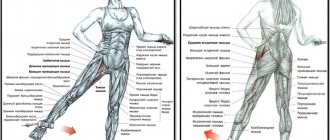If you have to choose, the three most common questions people ask about building muscle (not counting questions about how to bulk up certain body parts) are:
- How much muscle mass can you gain?
- How long does it take to get pumped up?
- How fast can you REALLY get pumped up?
More often than not, when people ask these questions, the response they get is something along the lines of, “Stop worrying about how long it will take or how fast it will happen...just shut up and go rock!” To a certain extent I understand the meaning of this answer, but more I understand why this is completely the wrong approach.
These answers are much more important than you think
Firstly, knowing the TRUTH about the speed and maximum muscle mass that, for example, can be gained in a month, you will be able to understand when the creators of various training programs, supplement manufacturers and other fitness gurus are lying to you, assuring you that you can build muscle much faster .
When you see that this is exactly what 95% of supplement manufacturers, workout program creators, and fitness experts promise every day, you will be less likely to fall for false promises.
Equally important, by understanding the actual rate and limits of muscle growth, you will have realistic expectations and will not set yourself impossible goals that will ultimately bring nothing but disappointment. Most of us (both men and women) expect to build a LOT more muscle in a FAR shorter period of time than our bodies are capable of.
men to rush from one stupid program to another, even crazier one, trying to find the one for “lightning-fast muscle growth”, which is impossible even with the use of steroids.
As a result, having not gained 5 kilograms of muscle mass in a week, which in their opinion they simply had to gain, people begin to blame it on the diet or training program and are embarrassed to change something that most likely should not have been touched (usually such changes only make things worse... “My biceps aren’t growing fast enough, which means I just need to do ten times more exercises!”).
For women, the situation is diametrically opposite. They also greatly exaggerate the expected muscle gain, BUT they do everything they can to avoid it because they don’t want to “bulk like a man.” That is why completely useless “Women’s workouts for muscle tone” appear almost every hour.
It doesn’t matter whether you are a man or a woman, you cannot achieve the desired result precisely because you do not understand what the real rate of muscle growth is and how much muscle mass you can gain in a month in the real world, and not in the world invented by the creators of advertising fitness programs. That’s why it’s time to analyze everything that will be written below and start changing right now.
What goals should you set for yourself?
You know, in many manuals for successful people, aspiring businessmen, etc. They write that you can’t set exorbitant goals. You can’t say that I want to earn a million. Goals should be step-by-step. For example, tomorrow I have to earn $100 in this and that way, and we are clearly moving towards the goal. The day after tomorrow another $150 and so on.
The same rules apply in bodybuilding. You can only get pumped up by progressing, achieving step-by-step goals and moving on. For example, I weigh 75 kg, but I want to weigh 90, but it’s perfectly clear to everyone that in a week you won’t weigh that much, and in a month too. Set a goal to weigh 76kg by the end of next month, follow the training regime, eat well, sleep, when you reach it, then move on to 77kg and so on. This is the only way to achieve results. New small achievements will delight you and give you an incentive to move on.
How Much Muscle Can You Gain... REALLY?
Year after year, thousands of smart people around the world never stop discussing how quickly and how many kilos you can actually gain. More than one study has been conducted on this topic.
Based on all this, over the course of your entire life you will be able to approximately gain the following amount of muscle mass (without resorting to medications):
- Average for men: about 18-22 kilograms of muscle over a lifetime;
- Average for women: about 9-12 kilograms of muscle over a lifetime.
Please note that in this case we are talking exclusively about muscles and not about weight. Of course, you can gain much more weight than muscle.
Also keep in mind that these are averages. There are always exceptions to any rule, who either cannot reach even the lower limit of the average, or easily exceed all the upper limits. This is influenced by a number of factors, so the indicators for each person will be different (we will talk about these factors a little later).
But for most people, most of the time... this is the maximum amount of muscle mass you can gain in your lifetime.
About the benefits of running
Running is one of the most natural activities for humans, both in history and for every person.
It is unique in its biomechanics, since a large number of muscles, ligaments and joints are involved in the work. The benefits of running are as follows: Lung function improves, gas exchange efficiency increases, and the cardiovascular system is strengthened. Oxygen enters the body tissues more efficiently, and the body is cleansed of toxins.
The body's immune system becomes more resistant to viruses and bacteria. If malignant cells appear, the body becomes more active in the fight against them.
The nervous system works more actively. Brain activity increases. Running helps cope with and prevent depression. To normalize sleep, running balances the sympathetic and parasympathetic nervous systems. A beneficial effect is achieved if you run no later than two hours before bedtime. Performance increases after training, the brain works faster than those who do not run. After running, the body produces more hormones such as endorphins, serotonin and dopamine, which, in fact, affects mood. The amount of fat in the body decreases, the body mass index returns to normal. This, in turn, creates a more attractive shape - an affordable cosmetic procedure, since it affects the buttocks, hips, torso, and face shape. Even a light jog can help burn hundreds of calories, but running is not a panacea in the fight against excess weight. Discipline in diet and regular physical activity, while an overweight person should not immediately start with intense training. Loads should be increased gradually. To combat excess weight and improve the functioning of the entire body as a whole, you should adhere to some rules of running training: Increase the level of load gradually and regularly. The body needs to adapt to new conditions. Ideally, if the process is controlled by a trainer who will advise on both loads and technique
But listening to the sensations while running, how the body reacts to training is very important. Regular training will lead to maximum benefits – even twice a week for 30 minutes, but regularly will bring benefits. If you like the process, you can increase the quantity, duration, include strength training for muscles, stretching for ligaments and joints. you can start with 15 minutes of running at a comfortable pace
If it’s hard, you can start walking. Don't think that this doesn't give you anything. Even regular 10 minutes of training has an effect. The most effective duration is achieved during a workout of 30 to 40 minutes.
However, there are contraindications for running: congenital heart disease, heart failure, thrombophlebitis of the legs, acute form of infectious disease, serious injury to the musculoskeletal system. Loads of low and medium intensity are beneficial. Because during excessive exercise, such as during a marathon or interval training, the immune system is weakened. It may take the body several hours or even several days to restore it.
Running is a great way to maintain good health and invest in your longevity. If you follow the recommendations and a disciplined approach, you can get a set of positive effects for the body, which are confirmed by scientific and medical research.
How long does it take to get pumped up...really?
So, we have determined the maximum possible increase in muscle mass. Next question: how long will it take?
Based on the performance of many of my clients and the clients of my colleagues, the results of a number of studies and my experience, which is more than 10 years, we can say the following.
Based on all this, the rate at which you can add muscle mass is as follows:
- Average for men: from 100 to 200 grams of muscle per week (this is about 0.5-1 kilogram per month);
- Average for men: from 50 to 100 grams of muscle per week (this is about 200-500 grams per month).
Again, this is pure muscle mass, not weight. In addition to muscle, the weight gained in a week can include (and most often does) fat, water and glycogen. But here we are talking exclusively about muscles.
And frankly, this rate of muscle growth is what you would expect under ideal conditions. That is, the ideal ratio of training and nutrients in the diet, the ideal amount of sleep every day, the ideal time for rest and recovery, the absence of stress and much more. Simply put, the closer your lifestyle is to this ideal, the faster you gain muscle mass (until you hit the ceiling described above).
And again... these are averages. Some people build muscle faster (rarely), others never reach that speed (the most common state of affairs). The exact amount of muscle mass and the rate of its gain per week, month, year depends on a number of individual factors. Speaking of factors, let's figure out what affects muscle growth.
What are basic exercises: purpose, advantages, rules
Many athletes do not know that it is not at all necessary to constantly complicate the exercises, as well as increase the load beyond their strength. If muscle mass is growing steadily, then there is no need to overwork. It is enough to perform a basic set of exercises. Sometimes this option is the only one available, for example, when there is sorely not enough time for full-fledged intense strength training. In such cases, this very basic program that we will present to you will help out.
The basic exercises in the gym for men are exercises that do not concentrate on anything specific. They are aimed at uniformly working several muscle groups at once.
The main purpose
When figuring out what kind of exercises these are, it doesn’t hurt to first find out what they are designed for, and most importantly, who and why they are best suited.
- Basic movements teach how to contract muscles correctly, gradually and consistently building up the muscle foundation. This is good news for beginners in the gym, because the correct execution of the exercises is what they need to think about first.
- For experienced athletes, they will become a kind of rest from grueling training and will allow you to maintain periodization (from light to heavy).
- Not all athletes consider sport a way of life; many consider it just a hobby. Basic exercises will allow them to practice without going too deep into the process, while still getting good results.
- By performing these simple movements, people belonging to different types can build muscle mass: mesomorphs and ecomorphs.
Even for those who have not yet fully learned to listen to their body, such a base will come in handy. Not only boys, but also girls take part in such programs; you shouldn’t discount them.
Advantages
Basic training in the gym for men has a number of advantages, without which it would be impossible to appreciate the full weight of such exercises.
We recommend reading: Exercises for losing weight on arms and shoulders at home for women without dumbbells
- Thanks to such activities, there is a noticeable acceleration of metabolism. This will help in quickly losing weight and maintaining normal body weight.
- Multi-joint exercises, which are included in the basic set, help to significantly increase strength, endurance, agility, and at the same time stimulate proper muscle growth.
- The whole body is worked out evenly, thanks to clearly calibrated, correctly selected exercises.
In addition, scientists have proven that by doing basic exercises, we stimulate the secretion of growth hormone and testosterone, which in turn are directly aimed at muscle growth. That is, anabolic hormones are produced faster and in greater quantities during such training.
Rules for exercising in the gym
The exercises included in the basic set help not only build beautiful, sculpted muscles, but also eliminate excess subcutaneous fat. They are quite complex and require a lot of energy expenditure from the athlete. Therefore, it is recommended to include it in the training program for everyone. However, before you start selecting options, it won’t hurt to familiarize yourself with the simple rules of training in the gym.
- Any workout, especially a basic one, must, unconditionally, begin with a warm-up. You can simply walk on a treadmill at medium power for about ten minutes or do a few bodyweight exercises. All this is aimed at warming up the muscles, which helps avoid injury during exercise.
- For beginners, immediately after warming up, starting the base, you can limit yourself to 1-3 exercises. It is not forbidden to make a few more insulating ones. This will be quite enough. More advanced athletes can regulate the load, number and time of training themselves.
- Don't chase quantity, this is the wrong tactic. It is better to concentrate on the correctness and clarity of the movements. The technique is very important, if it is not followed you can easily get serious injury.
It’s best to end your workouts in the gym with a special cool-down. You can do some stretching exercises at the same time. All this will reduce the intensity of lactic acid secretion, so the pain the next morning will not be so acute.
About recovery and training program
A properly designed training plan will help you achieve quick results. During the period of preparation and stimulation of hypertrophy, it is necessary to correctly combine basic and isolated exercises. For example, to pump up the pectoral muscles, you need presses. For enhanced hypertrophy, it is necessary to “injure” the muscle fibers, so presses are performed with heavy weights. And for increased growth in gluteal volume, you should focus on deadlifts and squats with weights. In general, anyone who wants to achieve results needs to master barbell work to build muscle.
When creating a training plan, you need to consider how much time different muscle groups require to recover. If you don't give them rest, there will be no progress and the athlete will quickly face burnout.
All large groups (lats and trapezius, pectorals, hips and buttocks) are restored within 72 hours. It takes about two days to restore the deltoids, triceps, biceps, and abs. Thus, you cannot train your back on Monday and Wednesday - the lats and trapezius simply will not have time to recover, which means there will be no result other than delayed onset muscle pain syndrome. But on Monday and Friday you can load this zone without fear
This is important to consider when working on a lagging group, as many make the mistake of loading one zone too often
Having figured out how much time it will take to pump up muscles, you should decide on the goal. Results that satisfy most people can be obtained in just six months, and the first progress is noticeable within a month. The muscles will acquire maximum volume after 24 months of regular training, but whether it is necessary to go further is something everyone decides for themselves.
Stage 2. The process of muscle hypertrophy i.e. muscle growth itself
This stage begins 2-3 months after the start of bodybuilding training in the gym. Normally, this stage should occur after the first, after you have prepared all body systems for strength work. Remember, if you missed the first stage, the second will not start properly.
This stage (muscle growth) doesn't take long, I gave you a rough guide, but it doesn't. Most, seeing that muscle growth would take 2-5 years, closed the page with a look of Oh why.
In fact, it takes 2 years for a muscle cell to inflate to its maximum size! Therefore, it will only take you 2 years to reach your maximum muscle growth potential.
Using the example of our guy, weighing 70 kg, these two stages will look like this: in the first 2-3 months he will increase his weight from 70 kg to 72-74 kg. During the second stage (over the next 2 years) he will actually increase the growth of muscle fibers (muscles), in the form of 10-15 kg in the first year and about 5-10 in the second year.
I guarantee that if a person exercises correctly, eats, rests, in general, does everything correctly, he will easily increase his weight from 70 to 90 kg, without the use of pharmacology.
That's basically all, I hope I answered your question - how long can it take to pump up. That is, if our guy does everything according to science, then in two years he will be able, roughly speaking, to pump up.
Another question is how to continue muscle growth, how can our guy grow further?) He has been training for 2 years, in fact, you can still train for a year or two, depending on the visible result.
But when our guy sees that there is really no progress, this means only one thing, his fibers have increased to the maximum and are no longer growing, so what should he do, how to live then.
The third stage of our today's release will come to the rescue - the stage of muscle hyperplasia.
Here he is! Anabolic hormone
I think you have already guessed that this is not only a matter of psychology and correct technique, because... I am not a supporter of only the mental side of any issue. I like to back everything up with scientific facts, without unnecessary pasta on my ears.
Anabolism – (from the Greek “rise”) or plastic metabolism – a set of chemical processes that are aimed at the formation of cells and tissues. In other words, anabolism is the construction of new cells and tissues of the body.
During exercise, protein (protein) in the muscles breaks down. Our body cannot ignore this, because... all the time strives for homeostasis (balancing the system), so it reacts with increased secretion of anabolic hormones. Hormones, in turn, make up for the lack of protein.
So, now that everything is clear, let’s move on. I think there is no particular point in describing in detail now all the biochemical processes that occur during physical activity, but it is simply necessary to talk about the hormones that are most important for muscle growth.
General recommendations
Bodybuilders most often resort to a training regimen in which they work a large muscle once a week, but this approach is not the most effective. This is especially true for those who are not used to working with heavy weights.
If many people think that this attitude to this training plan does not reflect reality, we can compare this scheme with the one that involves training twice a week, then the total number of classes per year is 54 versus 102, respectively. The conclusions suggest themselves.
In other words, it turns out:
- training once a week is the least effective;
- classes three times a week are most suitable for beginner bodybuilders;
- Training with a load on a muscle group twice a week allows you to improve strength indicators, get rid of excess fat deposits, and gain muscle mass.
Therefore, based on the above information, we can conclude that daily training for a specific muscle group will not produce results. Muscles are pumped best when they have time to recover.
Nutrition for accelerated weight gain
Although everyone should follow this rule, this is especially important for those who are trying to gain weight quickly. Eating often means eating five to six small meals a day that contain as many calories and nutrients as possible
This doesn't mean eating junk food and sugar, it means more protein and complex carbohydrates. If you want to gain healthy weight, don't store fat. Your snacks should be nutritious but high in calories, think about:
- nuts
- nut butter
- cheese
- dried fruits
- avocado.
And this is your evening snack. Forward!
And while this is a great way to gain weight, it's not healthy, so avoid sugary drinks and coffee. Replenish your fluid supply with plain water and smoothies (like an iced milkshake) or skim milk or juice shakes for a more active increase in calories.
5) Pump up your cardio
You've probably heard that "hard gainers" (i.e. people who have a hard time gaining muscle mass) are advised to give up cardio altogether. There is a grain of truth in this, but it is not completely true. When done correctly, there is room for cardio in a hardgainer program. Plus, you should never miss the opportunity to exercise your most important muscle—your heart. Big muscles won't stay big for life, and you'll still need a heart.
For these purposes, do low- to moderate-intensity cardio for 20-30 minutes. 2 or 3 cardio sessions per week will improve heart health, increase the rate of delivery of nutrients to the heart and reduce recovery time.
Development progress: main stages
All progress can be divided into several stages:
The body prepares for hypertrophy, that is, the growth of muscle fibers. This all takes about 2-3 months. This stage is key in matters of further weight gain. Strength indicators can grow at tremendous speed. Just a few workouts ago you bench pressed 60 kilograms, and today it’s 75-80. The process of hypertrophy. At this stage, the most important thing begins - muscle growth. On average, the duration of hypertrophy is not a year or two, but three to five years. But don’t rush to close the page - this is the maximum period. On average, potential can be realized in two years. The experience of thousands of athletes has shown that in two years it is quite possible to raise your weight from 70 to 90-100 kg, even without pharmacology. It is this difference in weight that will be the visible progress that many dream of. System adaptation. Here the emphasis is on those aspects that limit the growth of our muscles
That is, attention is paid to the circulatory system, heart, nerves, energy, etc. Unfortunately, only the most persistent reach this stage.
Nutrition
Only 30% of your figure is created in the gym, so, whatever one may say, 70% comes from nutrition. This applies to both gaining weight and burning fat. You can torment yourself with exercise machines for days on end, but not see the desired result if you don’t eat right.
“I’m on weight, that’s why I’m so fat now,” this can often be heard in the hall. Often the concept of “mass” is used as an excuse, as an excuse for oneself
During the period of weight gain, it is important to pay attention to the fact that it is muscle mass and not fat mass that is added. Many athletes in this phase begin to throw everything that lies crookedly into themselves, with one goal - to consume as many calories as possible. This is completely wrong
This is fundamentally wrong.
Of course, a calorie surplus is necessary - if we consume less energy than we expend, then there can be no talk of any growth. This is why we shouldn’t relax in the kitchen - we want what we eat to be deposited in our body. If you don't pay special attention to nutrition, your mass will become fat, not muscle.
So what to do? During the period of weight gain, you need to clearly understand what the body needs for muscle growth. First of all, proteins. This is what muscle tissue is made of. It is recommended to consume about two grams of protein per kilogram of weight per day - this is enough to provide the body with the necessary building material. Eat more poultry, fish, lean meat, legumes and, of course, cottage cheese.
Provide yourself with complex carbohydrates. Whole grain cereals and rice are excellent. Buckwheat is a real gift for an athlete; it contains many useful substances, in addition, it is tasty and high in calories. Eat plenty of vegetables, they contain essential vitamins and fiber. Also, don’t forget about fruits, but try to eat them in the first half of the day.
Many people underestimate the importance of fats and try to avoid them, but they are also important for gaining weight. Try to consume vegetable and unsaturated fats. Eat, for example, nuts, fish and avocados. Add extra virgin olive oil to your salad. Fats affect the production of testosterone, and, as you know, this hormone has a significant effect on the male body.
How much muscle mass can you gain in a year?
Beginners manage to gain up to 15 kg in total, but this is perhaps almost unrealistic. The maximum possible result is up to 500 grams per week (of course, this certainly does not happen week after week), but usually this figure is much lower. So if you are happy about gaining weight quickly, you shouldn’t, most likely it’s more fat than muscle. Approach the matter wisely and correct the situation.











